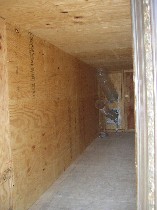 As I was trying to find my way into the Philadelphia Museum of Jewish Art at Rodeph Sholom Synagogue with not a post-Apocalyptic thought in my head when an open door gushed out some noxious odor that bore a resemblance to dry-cleaning fluid. Aaargh. Here it is, the beginning of the end of life, I thought. Here’s a picture (left) of the evil flexible duct that emitted the smell. (It looked scarier in person, and I had to hold my nose and stick my camera in the doorway to take the picture.)
As I was trying to find my way into the Philadelphia Museum of Jewish Art at Rodeph Sholom Synagogue with not a post-Apocalyptic thought in my head when an open door gushed out some noxious odor that bore a resemblance to dry-cleaning fluid. Aaargh. Here it is, the beginning of the end of life, I thought. Here’s a picture (left) of the evil flexible duct that emitted the smell. (It looked scarier in person, and I had to hold my nose and stick my camera in the doorway to take the picture.)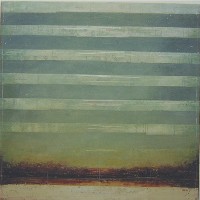 The experience seemed to foreshadow the show inside, “earthheavenhaveneden,” mixed-media paintings by Kathryn Frund that were supposed to be more about healing the earth than wallowing in the mess we have created.
The experience seemed to foreshadow the show inside, “earthheavenhaveneden,” mixed-media paintings by Kathryn Frund that were supposed to be more about healing the earth than wallowing in the mess we have created.
Frund said in her artists’ statement, “I began to seek a spiritual understanding of our role as stewards of the land”(right, “Sacred Narrative IV”, 30″ x 30″, which seems to fit the artist’s description).
But what I got out of them was dark indeed–a frustration with our failure to be effective stewards. The glowing light from above in no way vitiated the burnt-earth colors and atmosphere, which kept me thinking Anselm Kiefer thoughts.
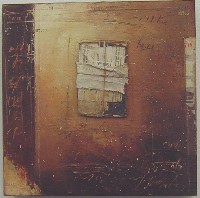 Bandage-wrapped rectangles affixed to the paintings somehow seem less about healing and more about the need to be healed (left, “Litmus and Faith II,” 11″ x 11″).
Bandage-wrapped rectangles affixed to the paintings somehow seem less about healing and more about the need to be healed (left, “Litmus and Faith II,” 11″ x 11″).Then there are the serial numbers stamped on the paintings, and the serial numbers scrawled on the sides of the paintings. I went straight to the Holocaust with those, the paintings tatooed like skin.
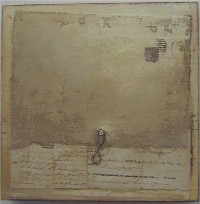 All of this is not to say I didn’t like the paintings. The paint is evocative and worked over, scumbled, scratched into with marks and words. Bits of documents like legal agreements, old insurance policies, property seizures and wills are collaged on and then partially obscured by paint. In “Litmus and Faith II” (left above) there’s a textual reference to property seized for auction; in “Rest II” (right, 11″ x 11″) a thread winds in a figure eight around two screws the way a string holds together the flaps of a manilla legal envelope. In some paintings, there are reports of natural occurrences; some have financial tallies or signatures of attorneys–suggestions of agreements made and broken or worn out by time.
All of this is not to say I didn’t like the paintings. The paint is evocative and worked over, scumbled, scratched into with marks and words. Bits of documents like legal agreements, old insurance policies, property seizures and wills are collaged on and then partially obscured by paint. In “Litmus and Faith II” (left above) there’s a textual reference to property seized for auction; in “Rest II” (right, 11″ x 11″) a thread winds in a figure eight around two screws the way a string holds together the flaps of a manilla legal envelope. In some paintings, there are reports of natural occurrences; some have financial tallies or signatures of attorneys–suggestions of agreements made and broken or worn out by time.
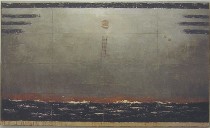 The show includes quotations from Genesis, Exodus and Isaiah posted on the wall. Putting this work in a religious context (it is religious work) enriches the images, but the work also stands on its own. The little wire ladders–one of them was affixed to “Sea Wall VIII” (left, 48″ x 80″)–seem a little obvious and reduce the paintings to their religious references, when for the most part they go in lots of directions.
The show includes quotations from Genesis, Exodus and Isaiah posted on the wall. Putting this work in a religious context (it is religious work) enriches the images, but the work also stands on its own. The little wire ladders–one of them was affixed to “Sea Wall VIII” (left, 48″ x 80″)–seem a little obvious and reduce the paintings to their religious references, when for the most part they go in lots of directions.
The paintings give a sense of each human being’s life as a passage or trip through time. The rectangles suggest tickets to ride, coffins or box cars or even ships for the journey. They also seemed like stand-ins for people, each rectangle an opportunity and a promise.
The work is beautiful and interesting–definitely worth my own life passage past the belching toxins. The curator of the shows at Rodeph Sholom is Matthew F. Singer, and the paintings were there courtesy of Pentimenti, Frund’s gallery ( I can’t get out of my mind a comment by Ed Sozanski in the Inquirer that Pentimenti’s owner, Christine Pfister, has a thing for square paintings; she does indeed, and these paintings were square, for the most part.)









